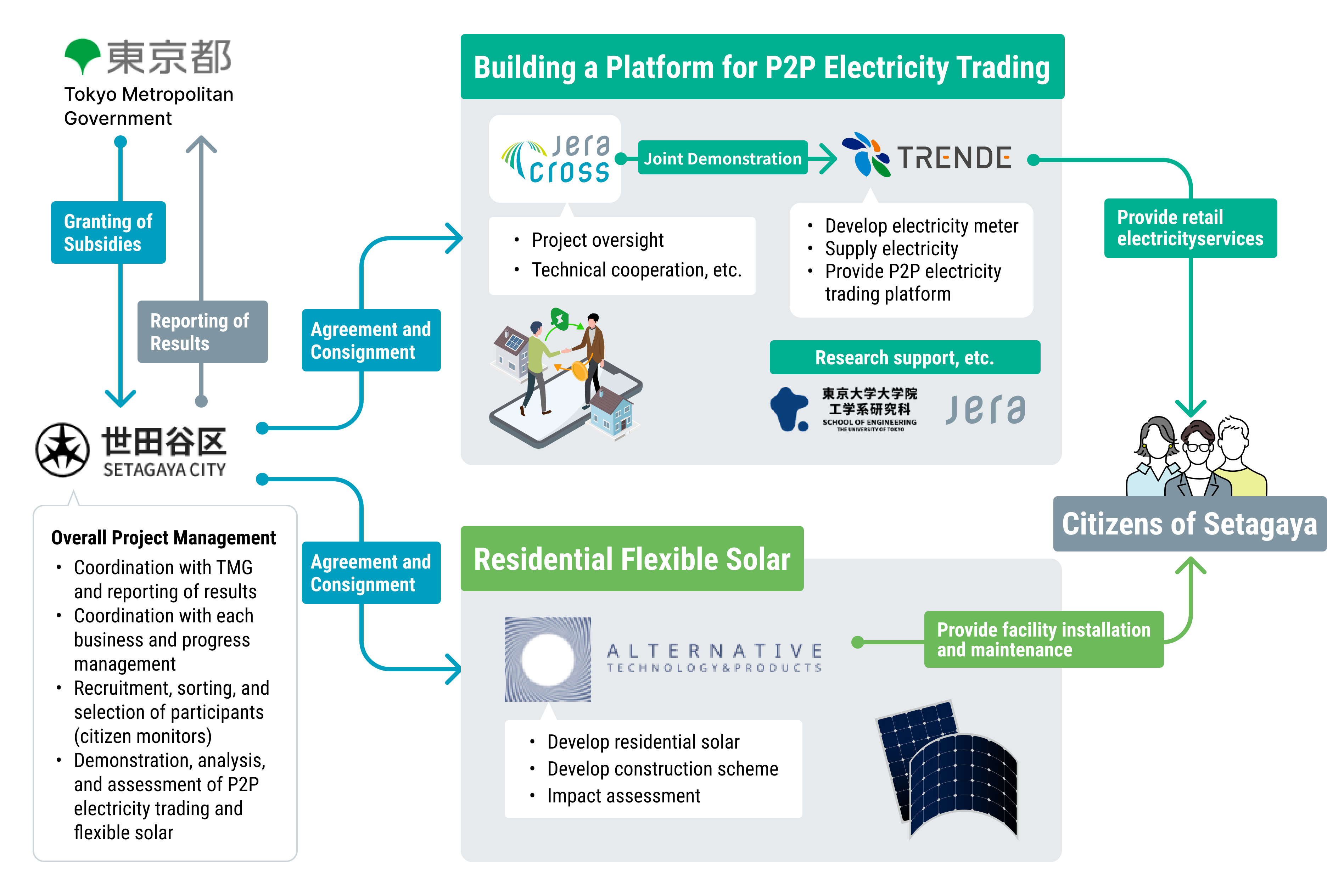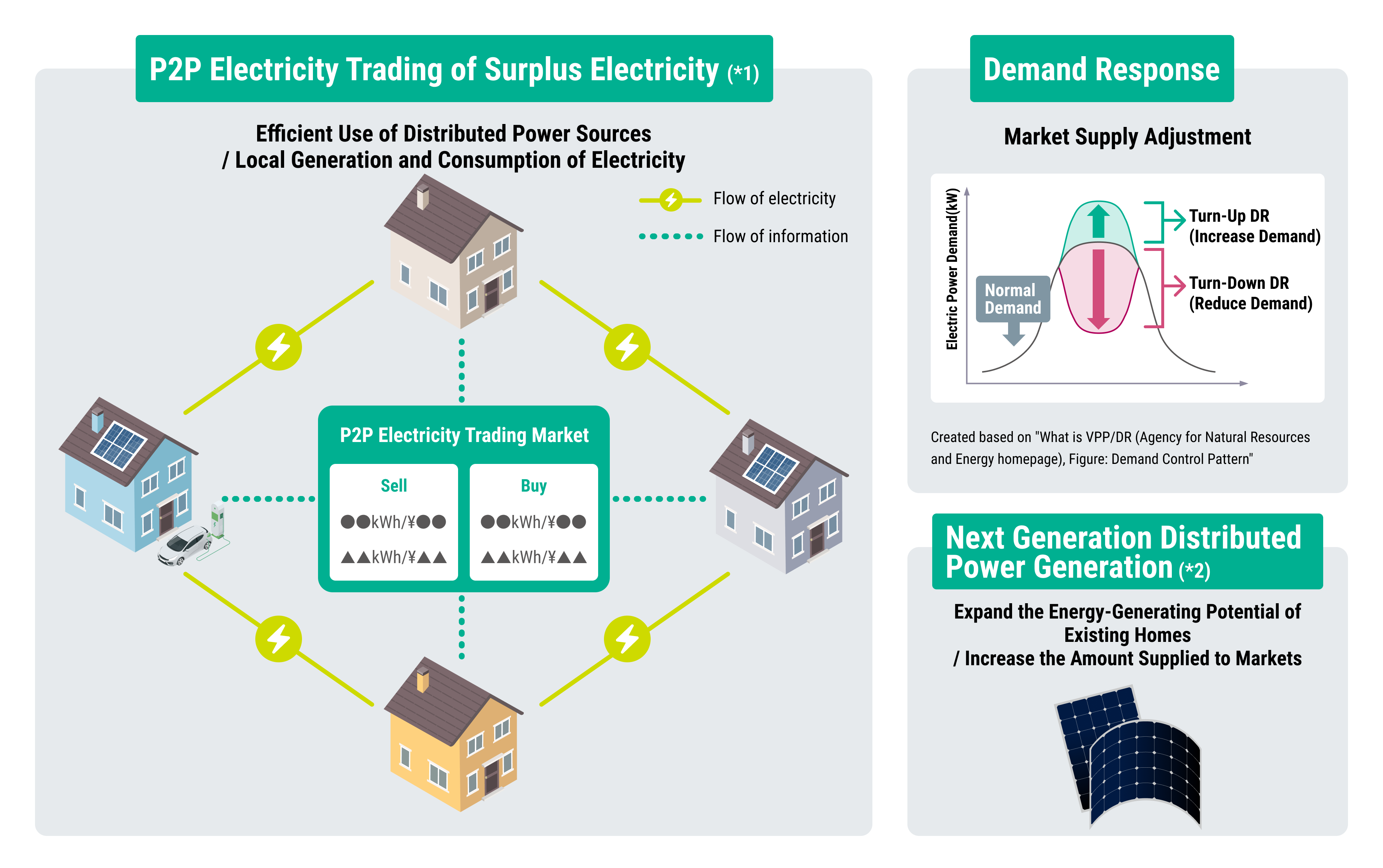Conclusion of a Basic Agreement to Promote the Decarbonization of Residential Areas by Using P2P Electricity Trading and Demand Response2024/10/17
Setagaya City (“Setagaya”), JERA Co., Inc. (“JERA”), JERA Cross Inc. (“JERA Cross”), TRENDE Inc. (TRENDE), Alternative Technology & Products, Inc. (“Alternative Technology & Products”), and the School of Engineering at the University of Tokyo (“the University of Tokyo”) have agreed to work together to promote the decarbonization of residential areas.
To generate renewable energy in urban areas where little space is available to install large-scale power generation facilities and the greatest potential lies in solar power generation on sites such as residential rooftops, it is crucial to maximize the potential of such renewable energy as well as its local generation and consumption. At the same time, as the adoption of renewables accelerates, fluctuations in the supply-and-demand balance and rising electricity prices have become societal issues, and hopes are growing for the social implementation of P2P electricity trading, a next-generation energy management platform that connects individual supply and demand. Furthermore, building regional energy networks that utilize distributed power sources is expected to enhance the value of renewable energy by invigorating local communities and promoting local generation and consumption.
The six parties, working together to leverage each party’s social decarbonization expertise, P2P electricity trading systems, and next-generation renewable energy facilities, will aim to establish ways to maximize the potential of residential-area renewable energy and its local generation and consumption.
* P2P (peer-to-peer) electricity trading: A mechanism for directly connecting energy producers (such as residential solar power) and energy consumers (local electricity consumers) through technologies such as blockchain to enable peer-to-peer electricity trading.
Setagaya City
In October 2020, Setagaya was the first of Tokyo’s twenty-three wards to declare the goal of achieving net-zero CO2 emissions by 2050. In March 2023, it revised its Local Plan for the Promotion of Global Warming Countermeasures, setting the target of reducing greenhouse gas emissions by 57.1% from 2013 levels by fiscal 2030. It is working in collaboration with residents and businesses to advance efforts aimed at achieving a decarbonized society.
JERA and JERA Cross
JERA and JERA Cross help corporate and municipal clients design visions for the future and formulate strategies aimed at achieving their Green Transformation (GX). They also provide end-to-end support from development to supply of the renewable energy needed for electricity decarbonization. In addition, JERA Cross, by ensuring a stable supply of electric power that emits no CO2 twenty-four hours a day, 365 days a year, aims to contribute to solving client issues, transforming client businesses, and reducing CO2 emissions.
TRENDE
While working to expand the adoption of distributed power sources through its Teraris service, which offers household solar power generation with no up-front cost, the company is also working to expand the adoption of P2P electricity trading systems that enable the local generation and consumption of power by encouraging the efficient use of distributed power sources.
Alternative Technology & Products
Offers a variety of unique, innovative solutions aimed at achieving the Green Transformation such as solar power generation systems that incorporate ultra-thin, ultra-lightweight, flexible solar panels that solve many of the issues associated with ordinary glass solar panels.
The University of Tokyo (Tanaka Laboratory)
Promotes research on data utilization in the building of advanced electrical power systems, including blockchain-based P2P electricity trading systems and other power distribution settlement systems, methods of forecasting and optimizing power supply and demand, and the application of electricity consumption data to other fields.
• Areas of Cooperation
・Maximizing the potential of renewable energy in residential areas as well as its local generation and consumption
・Methods that contribute to the above, and energy generation and storage facilities
・Power supply-and-demand methods that balance economic efficiency and environmental sustainability for citizens and utilize P2P electricity trading
・Efforts, driven by decarbonization initiatives, to enhance regional appeal by fostering a local circular economy and through community building
・Other initiatives that contribute to the decarbonization of residential areas
• Pilot Projects
In moving to decarbonize residential areas, we will conduct pilot projects in Setagaya related to the establishment of a P2P electricity trading market with demand response-based local energy management and to next-generation renewable energy facilities, as well as impact assessments to verify the feasibility of social implementation.
(Project Image 1 / Roles and Scheme)

(Project Image 2 / Project Content)

*1 Building a Network for Local Generation and Consumption Utilizing P2P Electricity Trading and Demand Response
• Target: Primarily residences in the Seijō area (assume a total of 300 homes including both buyers and sellers)
• We will demonstrate the establishment of an automated peer-to-peer (P2P) electricity trading network between intra-area electricity consumers and sources of renewable energy (non-FIT, post-FIT, etc.) currently sold to the grid as surplus. Additionally, the project will implement demand response measures that reduce demand during times when there is insufficient P2P electricity trading supply (“turn-down DR”) and increase demand during times when supply is abundant (“turn-up DR”). Incentives for market participation using the local digital currency Setagaya Pay will also be implemented to enhance liquidity for both electricity sellers and buyers and boosting the economic benefit of the market overall.
*2 Implementation of Next-Generation Distributed Electricity Sources (Flexible Solar / Reverse Power Flow Capable Batteries)
• Target: Primarily residences in the Seijō area (assume approx. 4 each)
• To address the various challenges related to installing solar panels on residences, such as building structure, aesthetics, and end-of-life disposal, we will conduct a demonstration and issue assessment of installations of commercial-use flexible solar panels on residential buildings, developing services tailored to residential use as we aim for social implementation. In addition, to efficiently utilize the electricity generated by residential solar, we will install batteries capable of reverse power flow to the grid in homes, demonstrating and assessing their use in a P2P electricity trading market.

